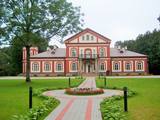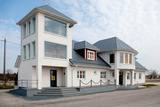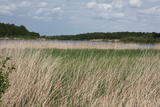| Nr | Name | Beschreibung |
|---|---|---|
|
Redāns ir 19. gadsimta beigās celtā Liepājas Jūras cietokšņa daļa, kur notikušas Latvijai nozīmīgas cīņas. Lai gan uzbūvētie nocietinājumi ap Karostu tika atzīti par stratēģisku kļūdu un vairums no tiem saspridzināti, Redāns palicis teju neskarts. Tā ir arī vienīgā nocietinājuma daļa, kur notikusi reāla karadarbība.Par liecina ložu šautie caurumi sienās. 1919. gada 14. novembrī šeit notika brīvības cīņas par neatkarīgu Latviju, aizstāvot Liepāju pret Bermonta karaspēku. 14. novembra rītā, pārejot aizsalušo Tosmares ezeru, bermontiešu kājnieki ieņēma Redānu. Taču dažu stundu laikā liepājnieki veica niknu pretuzbrukumu, un vāciešiem nācās atkāpties. Jūnijā, jūlijā un augustā katru dienu plkst. 11.00–17.00 pie Redāna gaidīs zinošs gids, kas būs gatavs pastāstīt vairāk par Liepājas cietoksni un vēsturiskajiem notikumiem Karostā. Cena – 2 EUR no personas. |
||
|
Alle Mitglieder der arbeitsamen Bauernfamilie produziert Räucherschinken und bäckt Brot. Das Fleisch wird nach den örtlichen Rezepten im selbstgebauten Räucherofen geräuchert, der dem Fleisch einen besonderen Rauchgeschmack verleiht. Das Brot wird aus qualitativen Vollkornroggenmehl gebacken. Brot und Schinken kann man freitags kaufen. |
||
|
After a big storm in 2005, the nature trail of the Randu meadows was restored. It is about 4 km long, and there is a bird-watching tower which offers a fine view of unique shoreline meadows with small lagoons and areas of reeds. It is a fine place to watch migrating birds. This is part of the Northern Vidzeme Biosphere Reserve (ZBR).
|
||
|
Akmensraga tāpat kā Kolkasraga apkaime jau kopš seniem laikiem ir bijusi zināma kā kuģotājiem bīstama vieta, jo te atrodas viena no lielākajām Latvijas piekrastes kuģu kapsētām. Bīstamības fakts slēpjas apstāklī, ka Akmensraga apkārtnē mainās krasta virziens un jūrā iestiepjas akmeņaini sēkļi. Pirmo signāluguni Akmensragā iededza 1879. g., bet 10 gadus vēlāk uzcēla 28 m augstu koka bāku. 1911. g. uzcēla mūra bāku, kuru sagrāva 1. pasaules kara laikā – 1916. g. Mūsdienās redzamā (augstums 37,5 m, uzbūvēta 1921. g.). Padomju laikā visas bākas bija militāri – stratēģiski objekti un šeit strādāja hidrogrāfiskais dienests un jūras novērošanas punkts. Bākas apkārtnē - mežā vēl joprojām redzamas bijušās padomju armijas ēku drupas. Apskatāma no iekšpuses. |
||
|
The excessively damp forests at this place include the Vēršupīte River bog, and this is one of the most diverse biotopes in Latvia in terms of the number of species that can be found here. The fact that the area is regularly flooded is shown by the fat roots of black alders – indeed, the place looks like a stand of mangroves. The wooden pathway that is the Dumbrāju trail starts at the Forest House for those who wish to examine the bog. The most impressive views are seen during spring floods or rainy seasons at other times of the year. The little river breaks out of its bed and floods a large territory. The Lake Sloka hiking trail is another place where you can study the Vēršupīte bog. The circular trail is 3 km long, and its beginning is at the Lake Sloka bird watching tower. |
||
|
Kale ist ein traditionelles Trawlerboot aus Holz, das auf dem Võrtsjärv eingesetzt wurde und das man wegen seines graziösen Aussehens oft auch für Vergnügungsfahrten nutzte. Das schlanke Segelboot hat zwei dreieckige Segel. Mit Unterstützung der Stiftung Võrtsjärve SA wurde im Jahr 2005 das Kale-Segelschiff „Paula“ 2009 das Kale-Segelschiff „Liisu“ angefertigt. Ein Kale-Segelschiff bietet ein echtes Erlebnis auf traditionellste Weise an. Auf Vorbestellung gibt es Fischsuppe und frischen Räucherfisch. |
||
|
A small food producer in Vidzeme, which is engaged in the processing of vegetables, fruits and berries, producing healthy snacks without sugar and flour. Offers tasting tours, master classes on vegetable truffles and healthy cakes, actively involving guests. Soon there will be a lunch offer - a special kale cabbage soup. |
||
|
The tour introduces a variety of attractions and values outside big cities revealing the true character of the countries. Visitors will experience the beauty of nature in national parks, charming ambience of rural manors, visit traditional rural farms and skilful traditional artisans and craftsmen. |
||
|
Das Ensemble des Gutes Alanta im Dorf Naujasodis besteht aus einem neoklassizistischen Herrenhaus, dem Park aus dem 19. Jh. (Ulme, Linde, Birke, Eiche, Traubenkirsche), Nebengebäuden. Im Park neben dem einer italienischen Villa nicht unähnlichen Herrenhaus mit neoromanischen Zügen gibt es Alleen, 3 unregelmäßig geformte Teiche. Die Bäume sind vielfach so gepflanzt, dass sich die Stämme beim Wachsen berühren und die Bäume gemeinsam gewissermaßen einen Strauß bilden. Neben einheimischen Gehölzen fehlt es auch nicht an exotischen. An der Grenze des Parks steht ein Altan mit Gitterwänden, ein mehrere Meter hoher weißer Obelisk und näher am Herrenhaus Marmorskulpturen von Venus und Jupiter. |
||
|
Eine aus Holz von den einheimischen Handwerkern nach der Finanzierung der Grafen Plater gebaute Kirche stammte von 1655 bis 1658 als eine nicht große einschiffige Basilika. Das einzigartige kulturhistorische Denkmal gilt als eine der ältesten Holzkirchen in Lettgallen. Die Schnitzerei des Zentralaltars in den Formen des Barocks wurde von den Meistern der Schnitzereischule von Stelmuže erschaffen. Im Seitenaltar befindet sich das Bild aus dem 18. Jahrhundert “St. Maria Magdalena”. Die Kirche wurde 1698 auf den jetzigen Platz – am rechten Daugava-Ufer befördert. Das Gebäude wurde mehrmals – 1890 und 1918 erneuert. Um die Kirche herum befindet sich einen Steinzaun aus dem Ende des 17. Jahrhunderts mit einem separat stehenden Glockenturm aus der Mitte des 19. Jahrhunderts, der 2002 restauriert wurde. Gemäß verschiedenen Informationsquellen kann man behaupten, dass die Gemeinde von Indrica die älteste in Lettgallen ist. |
||
|
Atrodas Vārtājas ielejas labajā krastā un labi saskatāms no Priekules – Grobiņas (P106) ceļa. Senās kuršu zemes – Piemares pilskalns, kas vēstures avotos pirmo reizi minēts 1253. gadā – līgumā starp Kurzemes bīskapu un Livonijas ordeni. Viens no lielākajiem Dienvidkurzemes pilskalniem. Iespējams, ka iepriekš – arī sens kulta kalns. Pagājušā gadsimta sešdesmitajos gados veiktajos arheoloģiskajos izrakumos konstatēts, ka pilskalns bijis apdzīvots jau vidējā dzelzs laikmetā. Pie tā konstatēta liela senspilsētas vieta. |
||
|
Im ehemaligen Gutshofpark von Müüsleri befindet sich eigenartiger Themenpark "Dorf der Schildbürger". Die Attraktionen im Park sind verbunden mit den Sagen von Schildbürgern, die schon vor 400 Jahren in Deutschland bekannt waren. Schildbürger sind Figuren aus einem Witzbuch, berühmt durch ihr unzweckmässige, irrsinnige Tätigkeit und Streiche. Im Themenpark werden humorvolle Erlebnistouren, Basteln, Verpflegung (für Gruppen auf Voranmeldung), Shopping und Zelten angeboten. |
||
|
Diese Route ist für aktive Fußgänger angemessen, denen es gefällt, Beobachtungen in der Natur mit der Erkundung der Kultur und Geschichte zu verbinden. Diese Route ist eine Reise in den Urstromtal des eindrucksvollsten Flusses der baltischen Länder – Gauja und in den tiefen Urstromtal seines Nebenflusses – Amata. An den Ufern der beiden Flüsse erheben sich landschaftliche Sandsteinfelsen der Devonperiode. Die Siedlung der Papierfabrik von Līgatne ist mit ihrem einzigartigen Dorfmilieu der Papierfabrik aus dem 19. – 20. Jh. ein ausgezeichnetes Beispiel des industriellen Erbes auch in Europa. Am Ende der Route kann man die mittelalterliche Burg von Cēsis – die größte Festung des mittelalterlichen Livlandes – besichtigen. Route information from Latvijas Lauku forums |
||
|
Der 1,2 km lange Verschlungener Pfad – Dünenbiotope der Halbinsel von Nordkurland, Landschaften der Ostseeküste, hunderte Jahre alte Kiefern im Dünensand, die häufig an Minituren von Urbäumen erinnern. Am Pfad neben dem ehemaligen Schießstand (auf dem ehemaligen sowjetischen Militärgelände) ist ein Aussichtsturm erbaut worden. |
||
|
The park was founded by the gardener Arvīds Janitens. Professor Raimonds Cinovskis has said that Arvīds is just amazing, because he alone did work that would usually be done by a big group of people. This is one of the most popular tourism destinations of its kind in Latvia.
|
||
|
Saimniecībā, kura atrodas pašā Sēlijas novada centrā, aug un zied vairāk nekā 400 dažādu rožu šķirnes, kā arī siltumnīcās tiek audzēti dažādi dārzeņu un puķu stādi. Iegādei tiek piedāvāti dažādi viengadīgie augi, vairāki simti rožu stādi un ēdamaugu stādi siltumnīcai un dārzam. |
||
|
Im Seezentrum im Hafen Sõru gibt es unterschiedliche Boote und Schiffe zum bewundern und werden kleinere Holzboote restauriert. Im Hafen liegt das dreimastige Segelboot "Alar" und wartet auf seine Restaurierung. Im Museumsgebäude gibt es eine ständige Ausstellung über die lokale Seekultur und es werden unterschiedliche Workshops über Strandkultur durchgeführt. |
||
|
Der wichtigste “Schatz” in diesem Territorium ist der flache und eutrophische See, der Heimat vieler wichtiger Vögel ist. Der See und seine Auenwiesen weisen auch viele verschiedene Pflanzen auf. Der Svētupe – Fluss fließt vom nördlichen Teil des Sees aus.
|
||
|
The craftsman offers useful household products such as terrines, pots to make pickles, dishes of sugar and salt, bowls, etc. You can learn about pottery traditions and watch as the kiln is opened. |
||
|
The ceramicist works in the household building of the Durbe Castle. You can watch her at work, try your hand at ceramics work, order artworks and purchase clay souvenirs. You can also tour the Durbe Castle complex, which is undergoing renovations at this time (2013). |
||



























